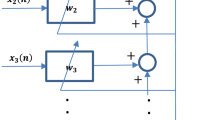Abstract
The uncorrelated component analysis (UCA) of a stationary random vector process consists of searching for a linear transformation that minimizes the temporal correlation between its components. Through a general analysis we show that under practically reasonable and mild conditions UCA is a solution for blind source separation. The theorems proposed in this paper for UCA provide useful insights for developing practical algorithms. UCA explores the temporal information of the signals, whereas independent component analysis (ICA) explores the spatial information; thus UCA can be applied for source separation in some cases where ICA cannot. For blind source separation, combining ICA and UCA may give improved performance because more information can be utilized. The concept of single UCA (SUCA) is also proposed, which leads to sequential source separation.
Similar content being viewed by others
References
S. Amari, A. Cichocki, and H. H. Yang, A new learning algorithm for blind signal separation,Advances in Neural Information Processing Systems, vol. 8, MIT Press, Cambridge, MA, 1996.
A. J. Bell and T. J. Sejnowski, An information-maximization approach to blind separation and blind deconvolution,Neural Comput., vol. 7, pp. 1129–1159, 1995.
A. Belouchrani, K. A. Meraim, J. F. Cardoso, and E. Moulines, A blind source separation technique using second-order statistics,IEEE Trans. Signal Process., vol. 45, pp. 434–444, Feb., 1997.
G. Burel, Blind separation of sources: A nonlinear neural algorithm,Neural Networks, vol. 5, pp. 937–947, 1992.
C. N. Canagarajah and P. J. W. Rayner, Linear adaptive decorrelator for signal separation,IEE Proc.—Vis. Image Signal Process., vol. 142, no. 5, pp. 327–332, Oct. 1995.
X. R. Cao and R. W. Liu, General approach to blind source separation,IEEE Trans. On Signal Process., vol. 44, no. 3, pp. 562–571, Mar. 1996.
J. F. Cardoso, Source separation using higher order moments,Proc. ICASSP, pp. 2109–2112, 1989.
C. Chang, Z. Ding, S. F. Yau, and F. H. Y. Chan, A matrix-pencil approach to blind separation of non-white sources in white noise,Proc. ISMIP'97, 1997 International Symposium on Multimedia Information Processing, pp. 280–285, Taiwan, Dec. 1997.
C. Chang, S. F. Yau, P. Kwok, F. K. Lam, and F. H. Y. Chan, Sequential approach to blind source separation using second order statistics,Proc. ICICS'97, First International Conference on Information, Communications and Signal Processing, pp. 1608–1612, Sept. 1997.
P. Comon, Independent component analysis: A new concept?Signal Process., vol. 36, no. 3, pp. 287–314, Apr. 1994.
S. V. Gerven and D. V. Compernolle, On the use of decorrelation in scalar signal separation,Proc. ICASSP, vol. 3, pp. 57–60, 1994.
C. Jutten and J. Herault, Blind separation of sources, Part I: an adaptive algorithm based on neuromimetic architecture,Signal Process., vol. 24, no. 1, pp. 1–10, July 1991.
K. Matsuoka, M. Ohya, and M. Kawamoto, A neural net for blind separation of nonstationary signal sources,Neural Networks, vol. 8, no. 3, pp. 411–419, 1995.
L. Molgedey and H. G. Schuster, Separation of a mixture of independent signals using time delayed correlations,Phys. Rev. Lett., vol. 72, no. 23, pp. 3634–3637, June 1994.
L. Tong, R. W. Liu, V. C. Soon, and Y. F. Huang, Indeterminacy and identifiability of blind deconvolution,IEEE Trans. Circuits Systems, pp. 499–509, May 1991.
Author information
Authors and Affiliations
Additional information
This work was supported in part by grants from the Research Grants Council of Hong Kong, grants HKU553/96M, HKU7036/97E, and HKUST776/96E.
Rights and permissions
About this article
Cite this article
Chang, C., Yau, S.F., Kwok, P. et al. Uncorrelated component analysis for blind source separation. Circuits Systems and Signal Process 18, 225–239 (1999). https://doi.org/10.1007/BF01225696
Received:
Revised:
Issue Date:
DOI: https://doi.org/10.1007/BF01225696




